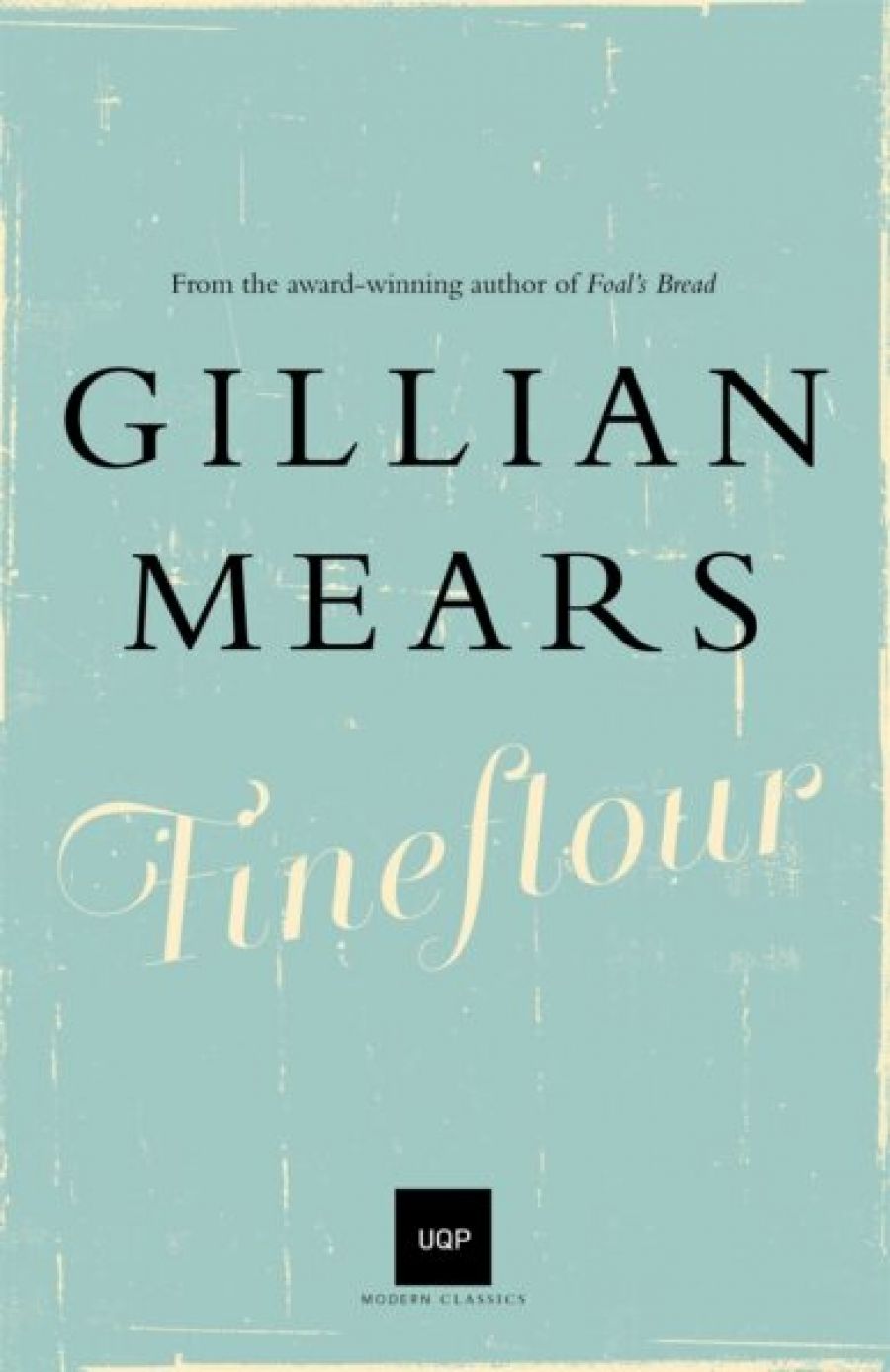
- Free Article: No
- Contents Category: Fiction
- Review Article: Yes
- Online Only: No
- Custom Highlight Text:
There’s something about country towns that makes them peculiarly well suited to being described in short stories. Or is it that short stories are particularly suited to describe life in country towns? Eudora Welty and Flannery O’Connor wrote about little else, and several Australian writers’ best books have been collections of stories set in country towns: Olga Masters’ A Long Time Dying, for example, and Frank Moorhouse’s The Electrical Experience. Gillian Mears’s Fineflour is a work which may be placed with absolute confidence beside any of those mentioned above.
- Book 1 Title: Fineflour
- Book 1 Biblio: University of Queensland Press, $12.95 pb, 190 pp
‘Fineflour’ is the name of both a river and the town it flows through, not on the coast but near enough to be affected by tides and to have the odd far-swimming shark become part of local mythology. The river is always there, a fundamental presence, playground, and burial ground. Many towns are like this, completely under the influence of a dominant natural feature: sea, desert, mountain range. Mears grew up in the ‘Big River Country’ towns of Grafton and Lismore in northern New South Wales, and her familiarity breeds not exactly contempt but a lack of the passing visitor’s romanticism.
She romanticises neither the river nor the people, and when her characters have romanticised someone, an absent lover or a friend, they are made to face up to their foolishness. Even Judy, grieving for her dear friend Gracie who died while still a lively child, acknowledges that her memory has erased all imperfections that weren’t adorable. The tragedy of Gracie’s death is told twice, in the stories that open and close the collection, with Judy as child and as adult trying to come to terms with her loss. They are courageous stories and breathtakingly good, packed with emotion and dignity.
Judy is a major character in two stories and appears peripherally in others. This is a device used throughout the collection which lends it an unobtrusive cohesion. Very few characters are ‘one-offs’. Observant young Stacey appears only in ‘From the Footbridge’, but in the course of that story she witnesses a piece of domestic drama in the Mann household, whose children are the prime movers in four other stories. Stacey doesn’t know why Hugh Mann (‘one of the senior boys she’d secretly do anything for and whose initials were scored across the back pages of her books’) is shouting at his father in their kitchen on a hot summer night, why Mr Mann is crying, why Hugh’s sister Kate picks up a teacup and deliberately drops and breaks it. Nor do we, exactly, but the preceding story, ‘Mothers and Old Lovers’, has given us a fair idea.
Her treatment of the Mann family’s predicament offers us an example of the insistently non-conforming nature of Mears’s emotional vision. The mother of Hugh, Kate, and their younger brother Mathew has left Fineflour and them. An abandoning mother, then, whom most writers would condemn via her children’s anguish. Certainly these three miss their Mum terribly, but she is not villainised, nor is there any attempt to justify or even explain her departure. Letting her just go, and the children grow up still loving her and getting on with life, is both refreshing and realistic.
How, one wonders, did someone as young as Gillian Mears get to know so much about how people’s hearts and minds actually work, let alone being able to write about it all so well? Not that you’ll learn her age in this edition: the biographical note omits that detail. You have to go back to her previous collection, Ride a Cock Horse (Pascoe Publishing) to find out that she was born in 1964. I assume that she deliberately left her age out of it this time in an attempt to avoid that tedious ‘young writer’ tag that came to dog Tim Winton. I sympathise, but it’ll be a rare reviewer – and not this one, I’m afraid – who will forbear from mentioning Gillian Mears’s remarkable combination of perceptiveness, writing talent, and relatively tender years.
What’s most heartening is that Mears seems already to have hit her stylistic stride, direct and deceptively simple. Take, as an example, the gritty opening paragraph of ‘Mothers and Old Lovers’:
Our dog died on Christmas Day and Dad made us dig the hole. You would’ve needed a crowbar to get it deep enough, the ground was that hard and we had to be ready by eleven for Erica’s Christmas lunch. So Dingus was popped into the back corner of the garden and at the time it hadn’t seemed to matter that his legs stuck out. He was a tall dog. It was too hot to cry.
The consequences of leaving old Dingus’s legs sticking out reveal themselves (so to speak) only at the very end of the story, and are pretty horrible even though you can’t help laughing – another Mears trait.
No wonder Mears has been raking in assorted grants and awards. Her next book, a novel called The Mint Lawn, has been awarded the Australian/Vogel Award and will be published by Allen & Unwin in late 1991.


Comments powered by CComment